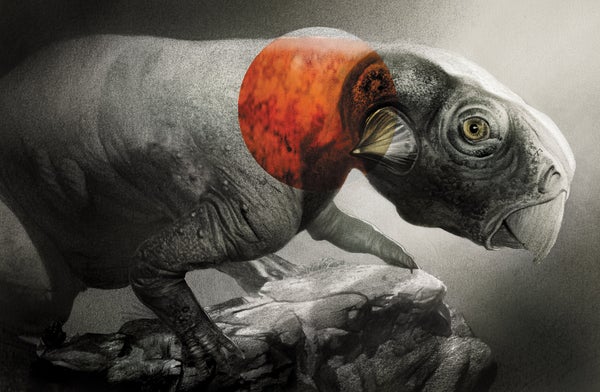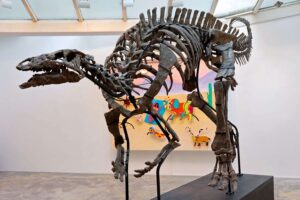Are Dinosaurs Coming Back? Unveiling the Truth!
Dinosaurs cannot come back as they went extinct about 65 million years ago. The possibility of their return remains purely within the realm of science fiction.
The wonder and fascination over dinosaurs have never ceased since their fossils were first discovered. These majestic creatures dominated the earth during the Mesozoic Era, leaving behind a rich fossil record that continues to captivate scientists and the public alike.
While modern science has made incredible strides in paleontology and genetics, the resurrection of long-extinct species, especially dinosaurs, presents insurmountable challenges. Movies like “Jurassic Park” explore the idea of bringing dinosaurs back to life, but these are based on fantasy rather than scientific fact. As technology progresses, the discussion often turns to de-extinction efforts, but currently, such a feat remains in the domain of theoretical discussion rather than practical application. Despite advances in DNA recovery and cloning technologies, we are far from witnessing the return of these prehistoric titans.

Credit: www.scientificamerican.com

Prehistoric Rebirth: Fact Or Fiction?
The idea of dinosaurs roaming the Earth again ignites the imagination of many. With groundbreaking movies and numerous books, this concept has been a part of popular culture for years. But the question remains: could we actually witness the return of these astonishing prehistoric creatures, or is it all just a fantasy?
Sifting Through Sci-fi Fantasies
Fiction often blurs the line between what’s possible and mere wishful thinking. Dinosaurs have been a cornerstone of sci-fi blockbusters, enchanting audiences worldwide. But let’s separate fact from fiction.
- Books and movies may exaggerate science.
- Actual scientific advancements move slower.
- Dinosaurs as seen in films remain improbable.
Exploring the realms of genetic engineering and cloning, reality tells a different story. It poses ethical and environmental questions we’re yet to answer.
The Science Behind De-extinction
De-extinction research is no longer just a subject of fiction. It’s a scientific endeavor with the goal of bringing back lost species. Scientists look at DNA to possibly revive extinct animals.
| Method | Explanation | Application |
|---|---|---|
| Cloning | Using DNA to create a genetic twin | Limited by DNA degradation over time |
| Genetic Engineering | Editing genes of a related species | Might produce a similar, but not identical, species |
| Selective Breeding | Encouraging traits over generations | Long process, outcome uncertain |
Scientists currently lack complete dinosaur DNA. That makes true dinosaur resurrection a dream for now. But research in this area fuels innovation and our understanding of life’s complexity.

Credit: www.amazon.com
Dino-dna: The Building Blocks For Resurrection
Dreams of resurrecting dinosaurs tease the imagination of young and old. While science fiction tantalizes with images of prehistoric creatures roaming modern landscapes, real-world science has begun unlocking the possibility through the study of Dinosaur DNA. This genetic material is our instruction manual to the past, offering a tantalizing glimpse into a world long gone. But where do we find these elusive building blocks?
Finding Fossils With Genetic Gold
Dinosaur fossils hold the secrets of the ages. Unlocking these secrets means finding fossils with well-preserved genetic material. While complete dinosaur DNA might be a stretch, recent discoveries hint at the potential of finding fragments that could help us understand these magnificent creatures.
- Soft tissues and bones can harbor preserved genetic material.
- Scientists extract and analyze protein sequences to reconstruct DNA blueprints.
- Paleogenetics offers a window into dinosaur appearance and behavior.
The Role Of Amber In Preserving History
Amber—nature’s time capsule—has always fascinated paleontologists. This golden resin captures and preserves organic materials like a snapshot from the past. Insects trapped in amber with dinosaur blood in their stomachs offer an indirect link to dino-DNA.
| Amber’s Role | Significance |
|---|---|
| Preservation Medium | Protects organic material from decay |
| Encapsulation | Prevents contamination by modern organisms |
| Data Source | May contain blood meal from dinosaurs |
Amber offers promising insights into the world dinosaurs lived in, enriching our understanding and fueling our hopes of one day resurrecting these ancient giants.
Revolution In Genetics: Crispr And Beyond
The thought of dinosaurs roaming the earth excites both young and old. Thanks to a leap in genetic science, this dream could turn into reality. CRISPR and other technologies are creating ripples in the vast ocean of genetics. They have unlocked doors that once seemed closed forever.
Tailoring Dna: The Crispr-cas9 Tool
Imagine a tiny pair of scissors that can cut and paste DNA. That’s what CRISPR-Cas9 does. It’s a tool that scientists use to edit genes with precision.
- Discoveries: Scientists found a way to edit DNA.
- Potential: They could bring back traits of ancient animals.
- Simplicity: CRISPR is simpler than older methods. It’s like changing text in a document.
This method has caused a shift in genetics. The tool targets specific DNA parts. It adds or removes genetic material. This can make extinct genes active again.
Synthetic Biology And Living Dinosaurs
Synthetic biology is another field making waves. It allows scientists to create new life forms.
- Foundation: Creating new genes from scratch is the goal.
- Achievements: New organisms with desired traits are already here.
- De-extinction: Future plans could lead to dinosaur-like creatures.
This exciting science may one day bring prehistoric traits into modern animals. These animals won’t be real dinosaurs. They will be new versions with some old features. The journey from ancient DNA to a walking creature is complex. But with each breakthrough, scientists move one step closer.
Ethics Of De-extinction: Morality Meets Science
The notion of bringing back dinosaurs stirs excitement and wonder. It sounds like a scene straight out of a movie.
Yet, scientific breakthroughs hint at its possibility. But with great power comes great responsibility.
Should science turn these dreams into reality? Let’s explore the ethical implications.
The Consequence Of Playing God
De-extinction begs a moral question. Is it right to resurrect extinct species?
Proponents argue for lost biodiversity. Opponents fear unintended outcomes.
We must weigh the moral costs against the scientific gains.
Ecological Considerations And Responsibilities
- Balance is delicate in ecosystems.
- Dinosaurs once dominated the Earth. Their re-introduction could disrupt current ecological harmony.
- We hold the responsibility to protect existing species.
Science must ponder these ethical dimensions before proceeding.
From Lab To Landscape: Reimagining An Ecosystem
Imagine a world where dinosaurs roam the lands as they did millions of years ago. Scientists and dreamers alike are now pondering the possibilities of turning this vision into reality. From extracting ancient DNA to reconstructing lost worlds, the journey from lab to landscape is filled with thrilling potential. Let’s dive into the future of our ecosystems, as we explore bringing prehistoric giants back to life.
Habitat Creation For Prehistoric Giants
Creating a home for dinosaurs in our modern age isn’t a simple task. Let’s consider the essentials:
- Expansive spaces to roam free
- Similar climates to their ancient habitats
- Abundant food sources that match their diets
- Safety protocols to protect them and us
This endeavor requires collaboration between paleontologists, ecologists, and engineers. The goal is to create sustainable ecosystems where these giants can thrive.
Balancing Modern Ecosystems With Ancient Life
Introducing dinosaurs into today’s ecosystems won’t be easy.
| Challenge | Solution |
|---|---|
| Potential for imbalance | Step-by-step integration |
| Impact on current species | Careful ecological assessment |
| Human-dinosaur encounters | Security measures and education |
By taking careful steps, experts ensure coexistence is safe and beneficial. They aim to enhance biodiversity while preserving the integrity of our current landscapes.

Credit: gagebeasleyprehistoric.com
Public Perception And Pop Culture Influence
The idea of dinosaurs roaming the Earth once again sparks imaginations and discussions worldwide. Often seen through the lens of movies and books, these prehistoric creatures influence trends, education, and entertainment. Digital effects bring them to life, offering a glimpse into a world long extinct. This fascination shapes the way society perceives ancient life and promotes a blend of knowledge and fantasy.
Dinosaurs In Media: More Than Just A Blockbuster
Dinosaurs captivate audiences both young and old, extending far beyond movie theaters. Their appearances in various media formats foster a deep-rooted curiosity about the prehistoric era. Let’s explore how dinosaurs continue to impact our modern world.
- Television shows breed curiosity among viewers with documentary-style storytelling.
- Books and comics offer visual and narrative exploration of dinosaur adventures.
- Video games allow players to interact with these creatures in virtual ecosystems.
Through these platforms, dinosaurs stimulate the imagination, merging fact with fiction and providing endless entertainment.
Educational Impact Of Dinosaur Revival
Beyond the screen, dinosaur themes impact learning in memorable ways. Interactive experiences bring the prehistoric classroom to life, inspiring future paleontologists. Here’s how the concept of dinosaurs benefits education.
| Method | Impact |
|---|---|
| Museum Exhibits | Provide tactile encounters, deepening understanding. |
| School Curricula | Stimulate student interest in science and history. |
| Educational Games | Foster discovery through play, reinforcing concepts. |
These educational tools bridge the gap between ancient history and modern-day excitement, making the extinct accessible and intriguing.
Frequently Asked Questions On Are Dinosaurs Coming Back
Will It Ever Be Possible To Bring Back Dinosaurs?
Bringing back dinosaurs remains unlikely due to DNA degradation over millions of years. Current technology cannot recreate authentic dinosaur DNA.
Will There Be Dinosaur In 2050?
No, dinosaurs will not exist in 2050 as they went extinct about 65 million years ago. Current animals are their closest living relatives.
What Is The Dinosaur In 2024?
The term “dinosaur in 2024” likely refers to a trending topic or a specific event relating to dinosaurs in that year. It doesn’t represent an actual species of dinosaur from prehistoric times.
Will Dinosaurs Reappear?
Dinosaurs are extinct and will not reappear naturally. Scientists cannot currently clone them as in science fiction scenarios.
Conclusion
As the curtain falls on our prehistoric discussion, one thing remains clear: dinosaurs, as they once roamed the Earth, are not returning. Despite advances in science, certain barriers prevent a full-fledged comeback. Yet, their legacy endures through fossil records and pop culture, inspiring awe across generations.
Let’s treasure the knowledge and keep exploring the ancient past that shapes our present understanding.




